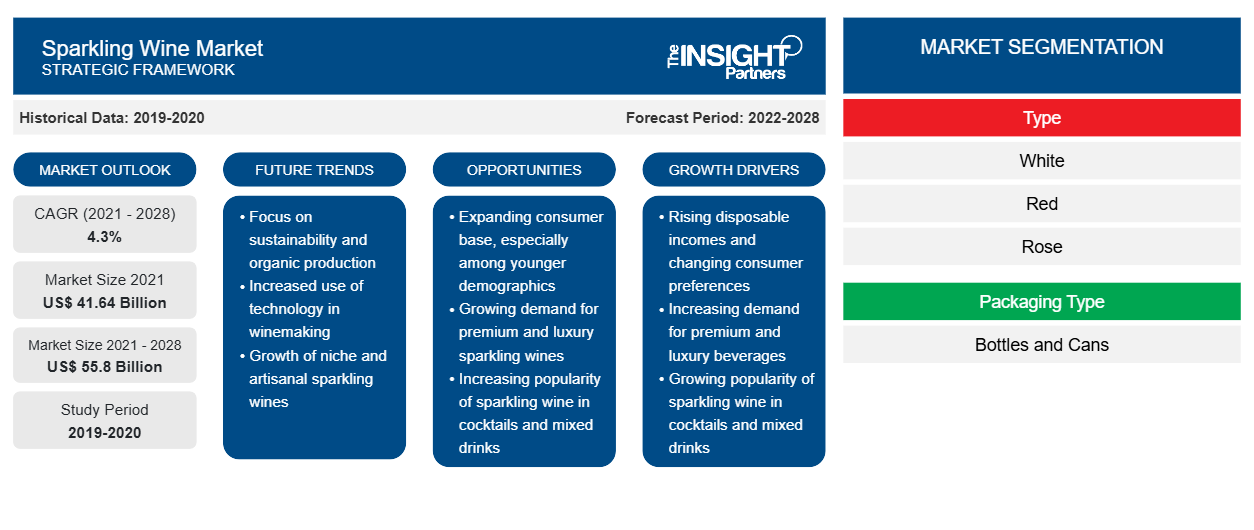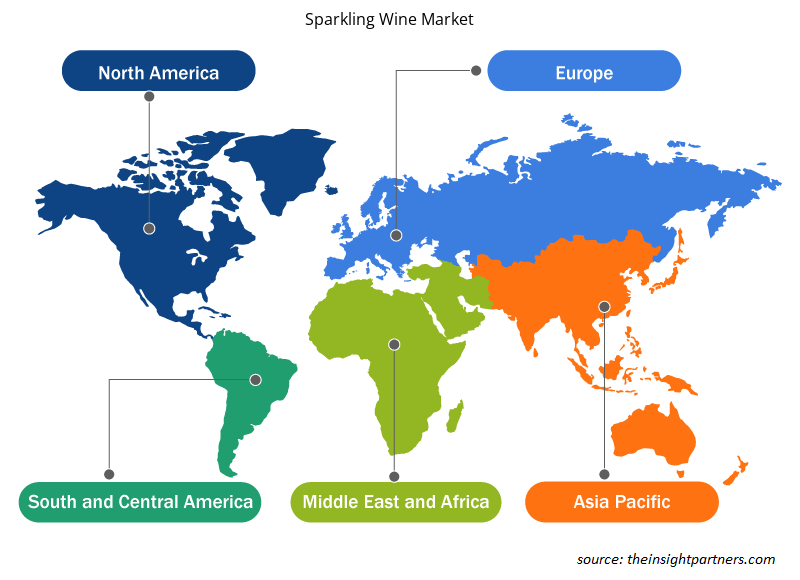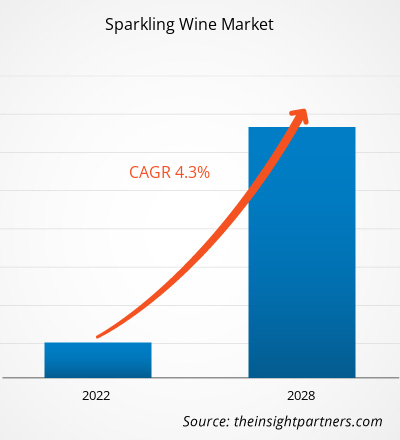The sparkling wine market was valued at US$ 41.64 billion in 2021 and is projected to reach US$ 55.80 billion by 2028; it is expected to grow at a CAGR of 4.3% from 2021 to 2028.
Sparkling wine is a variant of wine with a high carbon dioxide content, which adds additional bubbling to it. Champagne is one of the most widely popular types of sparkling wine. It is the wine manufactured in the Champagne region in France; however, many sparkling winemakers in the US use this name for their locally manufactured products.
In 2020, Europe accounted for the largest share of the sparkling wine market. The European Union (EU) has the largest concentration of sparkling wine producers. According to the Institute of Wine and Vine, the EU accounts for 70–80% share, by volume, of the global manufacturing of sparkling wine since 2000. According to industry experts, Europe exports a greater volume of sparkling wine than still wine in the international markets. The region has a long and illustrious history of winemaking. Wine lovers across the world prefer European sparkling wine owing to their unique flavors, tastes, and preparation methods. Moreover, increasing preference for less alcoholic beverages, growing influence of celebrities on the lifestyles of people, inclination toward convenience food and beverages, and the tradition of popping a bottle of Champagne or sparkling wine during festivities and celebrations, among others, justify the dramatic increase in demand for this category of wine. Europe has a highly established sparkling wine market, which consists of several prominent as well as small distillers.
Sparkling winemakers have been significantly affected by the scarce availability of workers during the COVID-19 pandemic, which hampered their production capacity. In addition, the shutdown of wholesale markets has compelled manufacturers to rely primarily on supermarkets and e-commerce dealers to sell their sparkling wine products. Despite the pandemic, there has been a rise in the sales of rose and sparkling wine.
Customize This Report To Suit Your Requirement
You will get customization on any report - free of charge - including parts of this report, or country-level analysis, Excel Data pack, as well as avail great offers and discounts for start-ups & universities
Sparkling Wine Market: Strategic Insights

- Get Top Key Market Trends of this report.This FREE sample will include data analysis, ranging from market trends to estimates and forecasts.
You will get customization on any report - free of charge - including parts of this report, or country-level analysis, Excel Data pack, as well as avail great offers and discounts for start-ups & universities
Sparkling Wine Market: Strategic Insights

- Get Top Key Market Trends of this report.This FREE sample will include data analysis, ranging from market trends to estimates and forecasts.
Market Insights
Increase in Popularity of Sparkling Wine
Rapid socioeconomic changes and fast-paced urbanization are bolstering the demand for sparkling wine. With continuous rise in living standards and buying power, customers desire to purchase high-quality, luxurious items. Moreover, their food habits and meal preferences change with these changes in lifestyle. Thus, the demand for sparkling wine in parties, marriages, and social gatherings is on rise. With the growing preference for drinks with low or no alcohol content, the popularity of this wine is increasing among millennials, teenagers, and working populations, and in bachelors and people living in hostels. Furthermore, the widespread use of social media and the Internet is significantly impacting all generations, while rise in number of parties and social events are contributing to the rise in consumption of sparkling wine globally, primarily in developed nations such as the US, Canada, Mexico, Germany, France, and Italy, thereby driving the sparkling wine market growth.
Type Insights
Based on type, the sparkling wine market is segmented into red, white, and rose. In 2020, the white segment accounted for the largest market share. White wine is made with Moscato Bianco grapes from Italy’s Piedmont wine region. Its production is primarily concentrated in Alba and the province of Asti in Northern Italy. The bubbles are caused by natural fermentation, which might occur in the bottle or a big tank. Fermentation occurs when sugar is added to wine and yeast acts on the sugar, generating carbon dioxide. Bubbles are formed in the wine as a result of the trapped carbon dioxide inside an enclosed environment.
Bacardi & Company Limited; Bronco Wine Co.; Casella; Constellation Brands, Inc.; Henkell Freixenet; Chandon; Schramsberg Wineyards; Pernod Ricard Winemakers; The Sparkling Wine Co.; Treasury Wine Estates Ltd; Bottega Spa; Campari Group; and Codorniu are among the key players in the sparkling wine market.
Sparkling Wine Market Regional Insights
The regional trends and factors influencing the Sparkling Wine Market throughout the forecast period have been thoroughly explained by the analysts at The Insight Partners. This section also discusses Sparkling Wine Market segments and geography across North America, Europe, Asia Pacific, Middle East and Africa, and South and Central America.

- Get the Regional Specific Data for Sparkling Wine Market
Sparkling Wine Market Report Scope
| Report Attribute | Details |
|---|---|
| Market size in 2021 | US$ 41.64 Billion |
| Market Size by 2028 | US$ 55.8 Billion |
| Global CAGR (2021 - 2028) | 4.3% |
| Historical Data | 2019-2020 |
| Forecast period | 2022-2028 |
| Segments Covered |
By Type
|
| Regions and Countries Covered | North America
|
| Market leaders and key company profiles |
Sparkling Wine Market Players Density: Understanding Its Impact on Business Dynamics
The Sparkling Wine Market is growing rapidly, driven by increasing end-user demand due to factors such as evolving consumer preferences, technological advancements, and greater awareness of the product's benefits. As demand rises, businesses are expanding their offerings, innovating to meet consumer needs, and capitalizing on emerging trends, which further fuels market growth.
Market players density refers to the distribution of firms or companies operating within a particular market or industry. It indicates how many competitors (market players) are present in a given market space relative to its size or total market value.
Major Companies operating in the Sparkling Wine Market are:
- Bacardi and Company Limited
- Bronco Wine Co.
- Casella
- Constellation Brands, Inc.
- Henkell Freixenet
Disclaimer: The companies listed above are not ranked in any particular order.

- Get the Sparkling Wine Market top key players overview
Report Spotlights
- Progressive industry trends in the global sparkling wine market to help players develop effective long-term strategies
- Business growth strategies adopted by companies in developed and developing markets
- Quantitative analysis of the global sparkling wine market from 2019 to 2028
- Estimation of the demand for sparkling wine from consumers
- PEST analysis to illustrate the efficacy of buyers and suppliers operating in the industry to predict market growth
- Recent developments to understand the competitive market scenario and the demand for sparkling wine
- Market trends and outlook coupled with factors driving and restraining the growth of the sparkling wine market
- Understanding on strategies that underpin commercial interest in the market, thus assisting in decision-making process for the market players
- Sparkling wine market size at various nodes of market
- Detailed overview and segmentation of the global sparkling wine market, as well as its industry dynamics
- Sparkling wine market size in various regions with promising growth opportunities
Sparkling Wine Market, by Type
- White
- Red
- Rose
Sparkling Wine Market, by Packaging Type
- Bottles
- Cans
Sparkling Wine Market, by Distribution Channel
- Supermarkets and Hypermarkets
- Specialty Stores
- Online Retail
- Others
Company Profiles
- Bacardi and Company Limited
- Bronco Wine Co.
- Casella
- Constellation Brands, Inc.
- Henkell Freixenet
- Schramsberg Wineyards
- Pernod Ricard Winemakers
- The Sparkling Wine Co.
- Treasury Wine Estates Ltd
- Chandon
Frequently Asked Questions
What is the forecast outlook of cans segment in the sparkling wine market?
Cans segment accounted for a minor share in 2020. Bottles re the most preferred type of packaging among sparkling wine consumers and manufacturers alike. However, cans can be used for single-serve and the recyclability has interested the eco-friendly consumers. Moreover, the young population that do not wish to buy an entire bottle are another target group expected to aid the growth of the cans segment over the forecast period.
Why is Asia Pacific expected to grow at the highest rate during 2021–2028?
Asia Pacific region accounts for a significant share of the global population and the rising disposable incomes and urbanization have contributed to the growth of the sparkling wine market in the region. The per capita consumption of wine is significantly low in the countries of Asia Pacific with respect to the western countries and this represents a significant potential for sparkling wine manufacturers. Moreover, interest in different varieties of sparkling wine from the countries such as China and India have also grown in the recent years.
Based on distribution channel, what was the largest segment of the global sparkling wine market?
Supermarkets and hypermarkets accounted for the largest share of the sparkling wine market in terms of distribution channel. The high footfall in supermarkets and hypermarkets makes it easier for sparkling wine manufacturers to target a wider customer base. The sparkling wine manufacturers mainly focus on selling sparkling wine via supermarkets and hypermarkets as they can enjoy the benefits of nationwide or area wide coverage and hence, generate a larger volume of sales.
Based on type, why is the rose segment expected to grow at the highest rate during 2021–2028?
Rose segment has been witnessing increasing popularity in recent years across the globe. Its distinct taste and color have increased its appeal among the population. Although it is a smaller category with respect to white, the segment has been registering significant growth in recent years.
Can you list some of the major players operating in the Global Sparkling Wine Market?
The major players operating in the global sparkling wine market are Bacardi & Company Limited; Bronco Wine Co.; Casella; Constellation Brands, Inc.; Henkell Freixenet; Chandon; Schramsberg Wineyards; Pernod Ricard Winemakers; The Sparkling Wine Co.; Treasury Wine Estates Ltd; Bottega Spa; Campari Group; and Codorniu among many others.
What is the scope of sparkling wine in the global market?
Sparkling wines are widely consumed across the globe, especially in western countries. They are available in bottles and cans, although they are mostly purchased in bottles.
Based, on type, the sparkling wine market is segmented into white, red, and rose. Packaging type segmentation includes bottles, and cans. Based on distribution channel, the global sparkling wine market is segmented into supermarkets and hypermarkets, specialty stores, online retial, and others.
- Historical Analysis (2 Years), Base Year, Forecast (7 Years) with CAGR
- PEST and SWOT Analysis
- Market Size Value / Volume - Global, Regional, Country
- Industry and Competitive Landscape
- Excel Dataset
Testimonials
Reason to Buy
- Informed Decision-Making
- Understanding Market Dynamics
- Competitive Analysis
- Identifying Emerging Markets
- Customer Insights
- Market Forecasts
- Risk Mitigation
- Boosting Operational Efficiency
- Strategic Planning
- Investment Justification
- Tracking Industry Innovations
- Aligning with Regulatory Trends
Yes! We provide a free sample of the report, which includes Report Scope (Table of Contents), report structure, and selected insights to help you assess the value of the full report. Please click on the "Download Sample" button or contact us to receive your copy.
Absolutely — analyst assistance is part of the package. You can connect with our analyst post-purchase to clarify report insights, methodology or discuss how the findings apply to your business needs.
Once your order is successfully placed, you will receive a confirmation email along with your invoice.
• For published reports: You’ll receive access to the report within 4–6 working hours via a secured email sent to your email.
• For upcoming reports: Your order will be recorded as a pre-booking. Our team will share the estimated release date and keep you informed of any updates. As soon as the report is published, it will be delivered to your registered email.
We offer customization options to align the report with your specific objectives. Whether you need deeper insights into a particular region, industry segment, competitor analysis, or data cut, our research team can tailor the report accordingly. Please share your requirements with us, and we’ll be happy to provide a customized proposal or scope.
The report is available in either PDF format or as an Excel dataset, depending on the license you choose.
The PDF version provides the full analysis and visuals in a ready-to-read format. The Excel dataset includes all underlying data tables for easy manipulation and further analysis.
Please review the license options at checkout or contact us to confirm which formats are included with your purchase.
Our payment process is fully secure and PCI-DSS compliant.
We use trusted and encrypted payment gateways to ensure that all transactions are protected with industry-standard SSL encryption. Your payment details are never stored on our servers and are handled securely by certified third-party processors.
You can make your purchase with confidence, knowing your personal and financial information is safe with us.
Yes, we do offer special pricing for bulk purchases.
If you're interested in purchasing multiple reports, we’re happy to provide a customized bundle offer or volume-based discount tailored to your needs. Please contact our sales team with the list of reports you’re considering, and we’ll share a personalized quote.
Yes, absolutely.
Our team is available to help you make an informed decision. Whether you have questions about the report’s scope, methodology, customization options, or which license suits you best, we’re here to assist. Please reach out to us at sales@theinsightpartners.com, and one of our representatives will get in touch promptly.
Yes, a billing invoice will be automatically generated and sent to your registered email upon successful completion of your purchase.
If you need the invoice in a specific format or require additional details (such as company name, GST, or VAT information), feel free to contact us, and we’ll be happy to assist.
Yes, certainly.
If you encounter any difficulties accessing or receiving your report, our support team is ready to assist you. Simply reach out to us via email or live chat with your order information, and we’ll ensure the issue is resolved quickly so you can access your report without interruption.















The List of Companies - Sparkling Wine Market
- Bacardi and Company Limited
- Bronco Wine Co.
- Casella
- Constellation Brands, Inc.
- Henkell Freixenet
- Schramsberg Wineyards
- Pernod Ricard Winemakers
- The Sparkling Wine Co.
- Treasury Wine Estates Ltd
- Chandon






 Get Free Sample For
Get Free Sample For